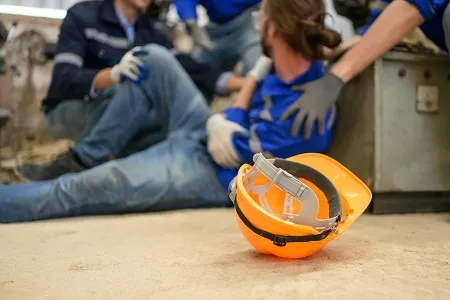Safety should be your number one priority when it comes to the workplace. Every year, thousands of accidents occur in the workplace, and many could have been prevented if they had followed the safety protocols.
Workplace safety policies in Australia are some of the most stringent in the world. This is because the Australian government takes workplace safety seriously and realizes it is critical to keeping workers safe. There are several safety policies that employers must abide by, and there are also several regulations that workers must follow.
This article will provide you with a comprehensive safety checklist to help keep your workplace safe.
What is Workplace Safety?
Workplace safety is a term used to describe a variety of measures taken to protect employees while at work. Workplace safety may include policies and procedures related to safety equipment, safe work practices, and emergency response plans.
Workplace safety is an important issue for both employers and employees. Employers must ensure that their employees are safe while working, and employees must take steps to protect themselves from potential hazards.
There are a variety of workplace hazards that can potentially injure or kill employees. Some common workplace hazards include: –
- Hazardous materials
- Heavy equipment
- Dangerous machinery
- Slips, trips, and falls
- Workplace violence
Employers should take steps to control or eliminate these hazards wherever possible. They should also provide employees with the appropriate safety equipment and training to work safely in their environment. Employees should familiarize themselves with the workplace hazards present in their environment and take precautions to avoid them.
Workplace Safety Checklist

To ensure a safe workplace environment, it is important to have a Workplace Safety Checklist. The Workplace Safety Checklist should include the following:
1. Inspection
Inspection is an important part of workplace safety. By routinely inspecting your workplace, you can identify any potential hazards and take steps to correct them. Some things you should inspect are:
Safety Equipment and Procedures
- Safety equipment: Ensure all equipment is properly functioning and in good condition. Safety equipment includes hard hats, safety goggles, and gloves.
- Safety procedures: Ensure all employees are familiar with the safety procedures for their workplace. Employees should know what to do in case of an emergency.
Workplace Layout and Design
When designing your workplace, it is important to consider safety. Some things you should keep in mind include the following:
- Clear walkways and exits: Ensure there are clear ones in an emergency. Employees should be able to evacuate the premises quickly and safely.
- Appropriate lighting: Ensure the workplace is well-lit, especially when employees work with hazardous materials or equipment.
Safety Signage
Make sure that all safety signage is visible and easy to understand. Employees should know the nearest fire extinguisher and how to use it.
Lighting and Ventilation
Good lighting and ventilation are important for workplace safety. Poor lighting can lead to accidents and injuries, while poor ventilation can lead to health problems. Some things you should keep in mind when it comes to lighting and ventilation include:
- Lighting levels: Ensure that the lighting levels are appropriate for the tasks performed. Employees should be able to see clearly what they are doing.
- Ventilation: Make sure that the workplace is well-ventilated. Employees should not be working in an environment that is harmful to their health.
2. Safety Protocols
It is important to have safety protocols in place in case of an emergency. Some things you should consider the following:
- Evacuation Procedures: Ensure all employees are familiar with the evacuation procedures for their workplace. Employees should know what to do in case of an emergency.
- First aid kit: Ensure that a first aid kit is readily available in case of an accident or injury.
- Safety training: Make sure that all employees receive safety training. Employees should be familiar with the hazards in their workplace and how to prevent them.
3. Chemicals and other hazardous materials
A chemical spill at a workplace can have serious consequences for the workers involved. If the spill is not properly cleaned up, the workers may be exposed to hazardous chemicals, which can cause health problems. When working with chemicals or other hazardous materials, it is important to take precautions to ensure safety. Some things you should keep in mind include the following:
- Safety Precautions: Ensure all employees know the safety precautions for working with hazardous materials. Employers need to take steps to prevent accidents involving hazardous materials. Workers should be trained to handle and clean up spills, and the workplace should have proper safety equipment.
- Safety Equipment: Employees should know what to do in case of an emergency. Ensure all employees wear the appropriate safety equipment, such as gloves and Safety goggles.
- Safety Signage: Make sure that all safety signage is visible and easy to understand. Employees should know the nearest fire extinguisher and how to use it.
4. Look for Potential Hazards and Address Them Immediately
Safety is a top priority in the workplace. This safety checklist can help you identify potential hazards and address them immediately. Some common hazards in the workplace include the following:
Tripping or Slipping Hazards
Some common tripping or slipping hazards in the workplace include the following:
- Wet floors
- Spills
- Uneven surfaces
- Poor lighting
- Clutter
Falling objects
- Make sure that all heavy objects are properly secured and in safe places
- Keep walkways and aisles clear of clutter and obstacles
- Avoid stacking boxes or other objects too high
- If you work with hazardous materials, make sure to follow all safety protocols
Chemical Exposure
Chemical exposure can be a serious issue in the workplace, and it is important to be aware of the dangers involved. Some chemicals can cause skin irritations, respiratory problems, or even death. It is essential that workers are properly trained in how to handle and use chemicals safely and that they understand the risks associated with exposure.
In Australia, WorkSafe is responsible for regulating workplace safety and has many regulations regarding chemical exposure. Some common symptoms of chemical exposure include the following:
- Headache
- Blurred Vision
- Nausea
- Sweating
- Dizziness
- Diarrhea
- Chest Pain
If you are exposed to any chemicals at work, follow all safety protocols. If you experience any of the symptoms listed above, seek medical help immediately.
Electrical Shock
When working with electrical equipment, it is important to take precautions to stay safe. One of the most common dangers is electrical shock. This can occur when you come into contact with electricity flowing through a circuit.
The severity of an electric shock can depend on several factors, including the amount of current flowing through your body, the length of time you are in contact with the current, and your body’s resistance. Some common symptoms of electrical shock include the following:
- Headache
- Nausea
- Chest pain
- Seizures
- Difficulty breathing
- Burns
- Dizziness
- Loss of consciousness
If you are exposed to any electrical current at work, follow all safety protocols. If you experience any of the symptoms listed above, seek medical help immediately.
Fire
Workplace fire accidents can be extremely dangerous and cause serious injury or death. Employers need to ensure that their employees are aware of the dangers of fire and know how to respond in the event of a fire.
Employees should also be familiar with the nearest fire alarm and fire extinguisher location. In the event of a workplace fire, employees should: –
- Remain calm
- Evacuate the building using the nearest exit
- Alert others by shouting and waving their arms
- Call 000 once they are safe
- If there is a fire extinguisher available, attempt to put out the fire
If you are exposed to any fire at work, make sure to follow all safety protocols.
Working in Extreme Temperatures
When working in extreme temperatures, it is important to take precautions to ensure your safety. In hot weather, drink plenty of water and wear light clothing to stay cool. When it is very cold, dress in layers to stay warm. Be aware of the potential for hypothermia and frostbite. In Australia, there are particular risks associated with working in the heat. The Work Health and Safety Regulations 2012 require employers to provide a safe working environment, including taking measures to protect workers from heat stress.
Working in extreme temperatures can cause several uncomfortable and potentially dangerous symptoms. You may experience headaches, dizziness, nausea, and vomiting when working in extremely hot weather. You may also find breathing difficult, and your skin may become red and irritated. In extremely cold weather, you may feel pain and numbness in your extremities, have difficulty breathing and feel exhausted. It is important to be aware of these symptoms and take appropriate steps to avoid them when working in extreme temperatures.
If you are exposed to extreme heat at work, make sure to follow all safety protocols. If you experience any of the symptoms listed above, seek medical help immediately.
Working in confined spaces
Working in confined spaces can be a hazard in the workplace. Some common symptoms of working in confined spaces include the following:
- Headache
- Nausea
- Dizziness
- Chest pain
- Difficulty breathing
If you are exposed to confined spaces at work, make sure to follow all safety protocols. If you experience any of the symptoms listed above, seek medical help immediately.
Noise exposure
Noise exposure can have a significant impact on workplace safety. In some cases, it can even lead to hearing loss, which can seriously impair someone’s ability to do their job safely and effectively.
Employers must take steps to protect their employees from noise exposure, such as providing earplugs or other hearing protection and ensuring that the work environment is as safe as possible. Some common symptoms of noise exposure include the following:
- Ringing in the ears (tinnitus)
- Headache
- Inability to hear high and soft -pitched sounds
- Muffling of speech and other sounds
- Watching television or Listening to music with a higher volume than others need
- Trouble understanding conversation at a distance or in a crowd
If you are exposed to loud noise at work, make sure to follow all safety protocols. If you experience any of the symptoms listed above, seek medical help immediately.
Repetitive Motion Injuries
Repetitive motion injuries are a common problem in the workplace, especially in Australia. They can be caused by doing the same task over and over again or by using the same motion repeatedly.
Some common repetitive motion injuries include carpal tunnel syndrome, tendonitis, and bursitis. These injuries can be very painful and can significantly reduce productivity. They can also lead to long-term disability if not treated properly.
Employers should take steps to prevent repetitive motion injuries by providing workers with appropriate safety equipment and training them to avoid injury. Workers should also take steps to protect themselves, such as using ergonomic equipment and taking breaks regularly. Some common symptoms of repetitive motion injuries include the following:
- Stiffness
- Swelling
- Pain
- Weakness
- Muscle cramps
- Tingling, pins-and-needles or numbness
If you experience any of the symptoms listed above, seek medical help immediately.
Stress
Workplace stress is a common problem, and it can seriously impact your health. You can do many things to manage workplace stress, including: –
- Taking regular breaks
- Exercising regularly
- Eating a healthy diet
- Getting enough sleep
- Taking time for yourself
- Practicing relaxation techniques
Some common symptoms of stress include the following:
- Headache
- Nausea
- Dizziness
- Chest pain
- Difficulty breathing
If you experience any of the symptoms listed above, seek medical help immediately.

5. All Employees Should Be Trained On Proper Safety Procedures
- Make sure all employees are trained on proper safety procedures. This includes wearing the correct personal protective equipment and following the safe work practices outlined in your company’s safety manual.
- Post regular safety audits to ensure that everyone is following the procedures and that there are no potential hazards in the workplace.
- Encourage employees to report any unsafe conditions or practices immediately. Safety should be a top priority for everyone in the workplace.
- If you have a safety committee, make sure they are meeting regularly to discuss concerns and brainstorm ways to improve safety in the workplace.
- Ensure you are up-to-date on all regulations and that your workplace is in compliance. This is vital to keeping everyone safe.
6. Provide personal protective equipment (PPE) for all employees and make sure it is in good condition
When it comes to safety in the workplace, personal protective equipment (PPE) is a critical component. All employees need to be provided with the proper PPE for their specific job duties and be familiar with how to use it safely.
Here are some tips for providing PPE for your employees:
- Review the types of PPE available and select the most appropriate for the tasks that your employees will be performing.
- Ensure employees are properly fitted for PPE and know how to use it correctly.
- Train employees on how to safely wear and use PPE and regularly remind them of these safety procedures.
- Maintain all PPE in good condition to effectively protect employees from potential injuries.
- Regularly inspect PPE to ensure it is still in good condition and meets all safety requirements.
Following these tips can help ensure that your employees are safely protected at work.
7. Training and Communication
Another important part of workplace safety is training. Employees should be properly trained in all safety aspects, including emergency procedures. Safety training should be an ongoing process, not only done once. Regularly conducting safety training ensures that your employees are always up to date on the latest safety procedures. As an employer, Induct For Work is a cloud-based software that helps businesses manage employee inductions. InductFor Work can be used to induct and train new employees, as it provides all the necessary tools and resources for a smooth transition into the workplace. InductFor Work online induction is an ideal tool for managing employee onboarding processes. It makes it easy for managers to create and track inductions and provides employees with an easy-to-use online portal.
Communication is also key when it comes to workplace safety. Employees should feel comfortable communicating any concerns they have about safety to their supervisors. Supervisors should also be proactive in communicating any changes or updates to safety procedures to their employees. By fostering open communication about the safety, you can create a more cohesive and safe work environment.
8. Encourage employees to report any safety concerns
Encourage employees to report any safety concerns they may have in the workplace. Workplace safety is of utmost importance, and any potential hazards must be identified and addressed as soon as possible. Employees can help keep themselves and their coworkers safe by reporting any safety concerns. Workplace safety is especially important in Australia, where workers’ compensation rates are among the highest in the world.
9. Investigate all accidents and near misses. Take corrective action to prevent them from happening again
Investigating accidents and near misses is an important part of workplace safety. By taking corrective action to prevent them from happening again, we can create a safer work environment for everyone. In Australia, WorkSafe investigates workplace accidents and incidents to help identify any safety issues that may need to be addressed. WorkSafe also provides guidance on how to create a safe workplace and prevent accidents from happening in the first place. Some of the key areas WorkSafe focuses on include the following: –
- Manual handling
- Electrical safety
- Chemical safety
- Slips, trips, and falls
- Fire
- Working with machinery
- Working at heights
For more information on WorkSafe and workplace safety in Australia, visit WorkSafe website. With the right policies and procedures, workplaces can be much safer for everyone involved. By WorkSafe investigating accidents and incidents, they can help to improve safety in the workplace and prevent future accidents from happening.
Workplace safety is a critical issue for any business. By following the workplace safety checklist, we can ensure that our employees are protected while working. In Australia, Workplace Health and Safety (WHS) legislation requires businesses to take all reasonably practicable steps to ensure the health and safety of their employees. This means providing a safe work environment, ensuring plant and equipment are safe and used correctly, providing information, training, and supervision to employees, and maintaining safe work systems.
While Workplace Health and Safety legislation varies between states and territories, the principles are the same. Businesses have a duty of care to ensure the health and safety of their employees and must take all reasonably practicable steps to minimize risks in the workplace.
Do you have any questions or great tips to share?
Induct for Work – the only online induction system you would need to run online inductions.



